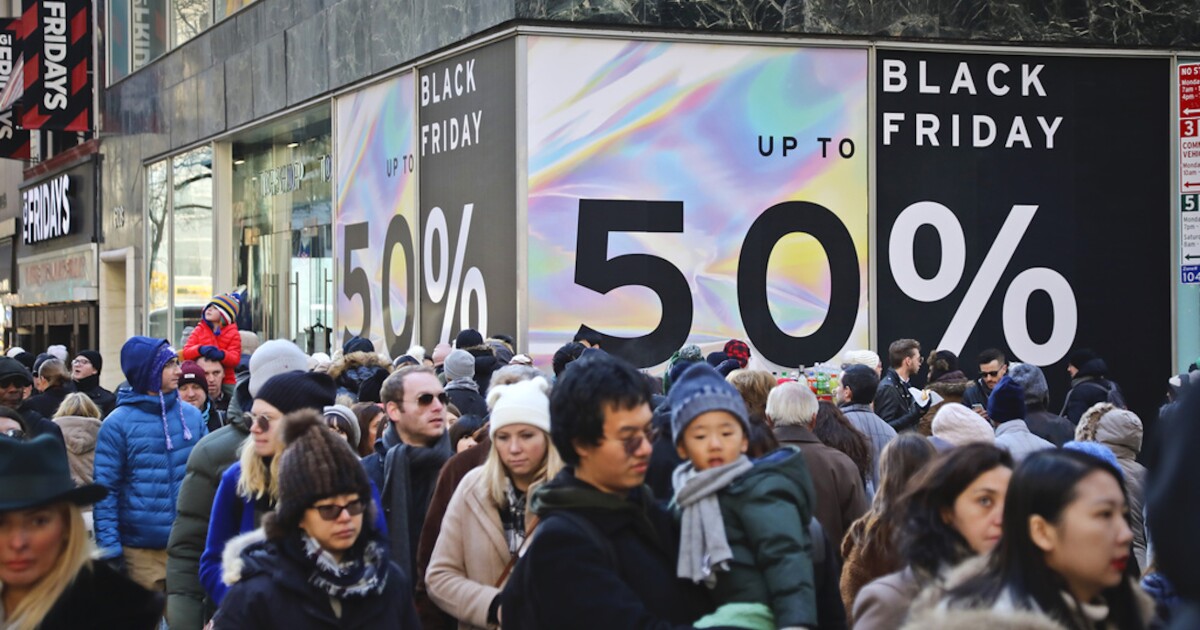

More than 200 million consumers shopped over the Thanksgiving weekend, which is a new record, according to the National Retail Federation.
Some 200.4 million people went shopping during the five-day holiday weekend that spanned from Thanksgiving to Cyber Monday, according to the NRF’s highly anticipated annual survey. The number exceeded the NRF’s expectations of 182 million shoppers by a healthy 18 million.
HOW PATRICK MCHENRY’S CONVICTIONS HELD THE HOUSE WHEN THERE ‘WAS NOTHING TO GUIDE US’
“We thought we’d have a big weekend, and we did,” NRF President and CEO Matthew Shay said during a Tuesday call with reporters. “We had a very big weekend. This was a major holiday — a record-setter.”
During the call, Shay said the average amount spent on items — including gifts, decor, and food — was $321. That is a very slight decline from last year.
A big chunk of spending during the five-day holiday weekend, which included Black Friday, was online, but consumers opted to shop in-person as well. Black Friday continued to be the most popular shopping day, with over 76 million shoppers visiting brick-and-mortar stores, up from 72.9 million the year before.
About 91 million consumers shopped online on Black Friday, up from 87.2 million last year. There was a slight decline in online shopping on Cyber Monday, though, with 73 million people doing so this year compared to 77 million in 2022.
The top gifts shoppers purchased during the five-day period were clothing and accessories, toys, gift cards, books, video games and other media, and personal care or beauty items.
“The takeaway for us is that we continue to expect a healthy [and] strong holiday season. Consumers are spending, and they’re finding great opportunities and deals,” Shay said. “According to the self-reporting, holiday shoppers still have about half of their holiday shopping remaining between now and the end of the year.”
Despite the weekend breaking records, some analysts expect this holiday shopping season to be more muted than in years past. Ted Rossman, senior industry analyst at Bankrate, noted that October’s retail sales fell slightly from September despite more people indicating they planned to start holiday shopping earlier this year.
“The complete November retail sales figures won’t be in for a couple more weeks, but I’m getting the sense that consumers are in a frugal mood this holiday season,” Rossman said, noting the slight decline in the average amount spent at stores this past weekend.
The NRF expects holiday spending to increase by between 3% and 4% from last year, with shoppers set to spend up to $966.6 billion this month and in December. That expected growth is right in line with pre-pandemic growth trends, according to the researchers. From 2010 to 2019, annual holiday spending grew by 3.6% on average.
But Rossman said it appears increasingly likely that holiday sales will end up falling short of the NRF’s projections.
“That figure basically matches the inflation rate, so if you adjust for inflation, recent retail sales figures show a net decline versus last year,” he said. “It makes sense since inflation and high interest rates have been squeezing consumers for a while now.”
There are other indications that retailers are expecting a more muted holiday spending season this year.
While retailers load up on seasonal workers every year to keep up with the uptick in shopping, this year, there has been less of a surge in hiring than in the past few years. The NRF expects employers to add between 345,000 and 445,000 seasonal workers to their payrolls — that is as much as 40% lower than the recent peak in 2021.
Additionally, outplacement services firm Challenger, Gray, and Christmas expects that retailers will add some 410,000 seasonal positions, which would be the lowest number of retail jobs added in the fourth quarter since 2008.
CLICK HERE TO READ MORE FROM THE WASHINGTON EXAMINER
“With inflation slowing, companies, particularly retailers, won’t be able to pass increased labor costs to the consumer as easily,” Andrew Challenger, head of sales and media at Challenger, Gray, and Christmas, recently told the Washington Examiner. “This could lead to more cuts, rather than more added positions, as evidenced by the increase in job cuts in this sector.”
Overall, the country’s labor market has remained resilient despite the Federal Reserve holding interest rates at their highest level in years. Still, the economy added 150,000 jobs in October, fewer than most economists had projected.





